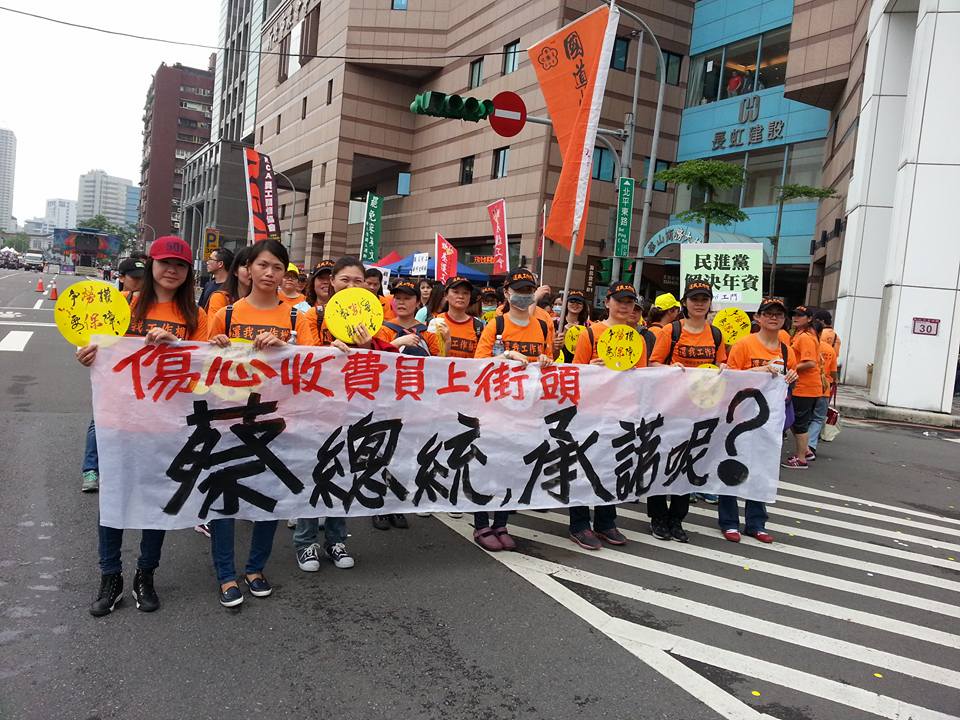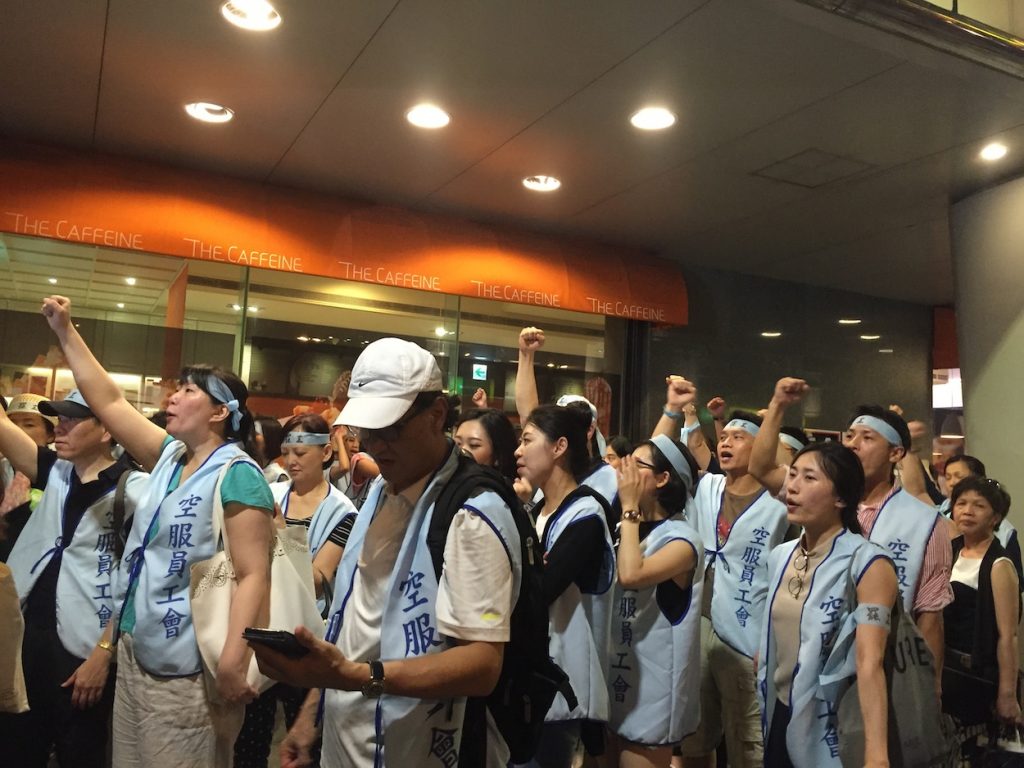by Brian Hioe
語言:
English
Photo credit: 國道收費員自救會
LABOR STRUGGLES regarding transportation workers in Taiwan would seem to have taken center stage in the months after the China Airlines strike that took place in late June. Tuesday saw a demonstration by the Former Freeway Toll Collectors Self-Help Organization outside the Legislative Yuan. In the near future, it is also possible that Taiwan Railways workers will unofficially strike over the mid-Autumn festival through workers calling in holidays for the mid-Autumn festival from September 15 to September 18, with a formal strike to take place on January 1st.
Demonstrations by laid off freeway toll workers have been ongoing for the past several years, with toll workers being laid off after the introduction of an electronic tolling system in 2014. Workers began to demonstrate in 2013 regarding inadequate severance packages after lay-offs. Workers continue to demonstrate in the present regarding a lack of any concrete plan by the Tsai administration to address their continued labor issues.
Under a contracted labor settlement with the Taiwan National Freeway Bureau, the Far Eastern Electronic Toll Collection was supposed to find laid off freeway toll workers work after they were laid off. However, seeing as more than 180 of 954 laid off workers have not been given replacement work yet, workers continue to demonstrate. Far Eastern Electronic Toll Collection is a privately owned company affiliated with the Far Eastern Group, but is contracted by the Taiwan National Freeway Bureau to run electronic tolling on highways for the Taiwanese government. According to some claims, laid off toll workers have held more than one hundred demonstrations in the past two years.
 Demonstrating toll workers. Photo credit: 國道收費員自救會
Demonstrating toll workers. Photo credit: 國道收費員自救會
Demonstrations for the past several years, then, have been organized through the Former Freeway Toll Collectors Self-Help Organization and seen support from Taiwanese civil society and youth activism. The recent demonstration outside the Legislative Yuan took the form of a vigil by approximately twenty workers who stated that they would refuse to leave until their demands, but ended with an announcement shortly after midnight. Workers stated that after union representatives met with Lin Wan-i of the Executive Yuan and Minister of Labor Kuo Fang-yu, a settlement had been reached, bringing an end to two years of struggle, and that details would follow shortly.
The demonstration of laid-off freeway toll workers comes on the heels of recent labor demonstrations which have managed to win concessions from management—sometimes with the intervention or involvement of the Tsai administration, as was most dramatically seen with the China Airlines strike. Notably, key organizers of the China Airlines strike had been involved in the toll collectors’ struggle since the beginning, such as noted labor activist Mao Chen-fei. Yet if this bring an end to the two years of struggle by the Former Freeway Toll Collectors Self-Help Organization, the possibility of a future strike by Taiwan Railways workers can also be connected to recent labor uprisings.
A strike planned before a major travel period proved an effective tactic for China Airlines workers, which is presumably why Taiwan Railways workers would threaten to strike over the mid-Autumn festival. In the case of the China Airlines strike, management was forced to back down after mass flight cancellations ensued because of the strike.
After the China Airlines strike, this was inspiring of workers in the transportation industry writ large to organize. Subsequently, workers from affiliated Mandarin Airlines, Huaxin Airlines, and bus company workers also threatened to strike. Connected to the nature of many of these transportation companies as state-owned or partially state-owned enterprises, this also led to threats to strike from workers of state-owned power utility company Taipower Company and from workers from the state-owned Chunghwa Post and Chunghwa Telecom, which was formerly state-owned but has since privatized. Sometimes the threat of a strike has been enough to win concessions from management, as occurred in the case of workers from a Changhua power plant run by Formosa Plastics that sells power to the Taipower Company.
 Demonstrating flight attendants during the China Airlines strike. Photo credit: Brian Hioe
Demonstrating flight attendants during the China Airlines strike. Photo credit: Brian Hioe
After the China Airlines strike, the strategy of attempting to appeal to the public to force government intervention has also become increasingly common in Taiwanese labor. Government intervention in the case of transportation industry strikes tends to be a very likely outcome because of close ties between the transportation industry and government in Taiwan. China Airlines is, for example, a partially state-owned enterprise in which the Ministry of Transportation and Communications still has the controlling share. We can see this as well in the case of laid off toll workers, and the frequent contracting of elements of the transportation industry to private sector companies with heavy public investment, whether with electronic tolling in the case of Far Eastern Electronic Toll Collection or other cases as with the EZCard Corporation which manages the electronic card system used for subway tolls in Taipei Metro stations.
In the case of Taiwan Railways, Taiwan Railways is a state-owned enterprise. Indeed, there has not yet been another major strike in the Taiwanese transportation industry, either public or private, since the China Airlines strike. But if we examine recent trends in labor activity, it generally is that labor activity is on the uptick in industries and companies with close ties with the government, inclusive of the transportation industry. Again, this may return to that appeals to the Tsai administration to intervene behalf of workers is an increasingly common strategy for labor strikes since the China Airlines strike.
With recent controversy regarding the Tsai administration’s policy of one set day off for workers per week and one flexible rest day, controversy has ensued because workers can still be made to work on their flexible rest day. Likewise, with the change in labor regulations, seven public holidays were to be cut. Despite demonstrations from workers leading to the Tsai administration backing away from the plan, and then further demonstration leading the Tsai administration to reverse its course regarding cuts in public holidays, the course the Tsai administration will follow still remains opaque. In large part, this is because of strong opposition from leaders of large business groups, who threatened to terminate all negotiations regarding wages with the Ministry of Labor if the Tsai administration plan. The Tsai administration has vowed to take a middle course, to balance the rights of workers and bosses.
But Taiwan Railways workers would be demonstrating regarding that despite new labor regulations affecting schedule arrangements, Taiwan Railways has not hired new staff to compensate for labor shortages, leading to new labor regulations actually increasing the workload of Taiwan Railways workers who are then forced to work overtime hours. Workers are in some cases not paid for night shifts and their schedules are not arranged in order to actually allow workers a full 24 hours off, despite that by law they should be allowed this, and workers themselves often have to factor in their own commute times regarding travel between work and home. Workers are also calling for management to pay them overtime pay that they are owed.
In particular, in cases of strikes in the transportation industry, striking workers run the risk of management turning public sentiment against them. Management will use the inconveniences suffered by the public because of train, bus, or plane cancellations in order to paint workers as inconveniencing the public for their own laziness in not wanting to live up to their duty as workers. This rationale was used to in the past to attack planned labor reforms by the Tsai administration, with the management of bus companies pointing towards reductions in scheduling as an negative effect for the public of regulations limiting the amount of hours that workers can work.
The same attack would likely be made on workers from any state-owned enterprise which manages a public utility going on strike, for example, as would probably be the case if Taipower workers or Chunghwa Post workers went on strike. In the case of the Tsai administration intervening in labor disputes, a large factor in past successes as the China Airlines strike has been because public sentiment was on the side of workers. However, it is possible that public sentiment may turn against workers who are perceived as striking too much and inconveniencing the public for their own greed or laziness. The patience of the Tsai administration may also run out because of pushback from leaders of large business groups. The strategy of appealing to the public to force government intervention from the Tsai administration may thus eventually lose its effectiveness.
This may be a challenge faced by Taiwanese labor in the future, which may require a shift in tactics. However, it is that labor struggles in Taiwan continue. Two months after the China Airlines strike, labor activity in Taiwan continues to be on the rise.

